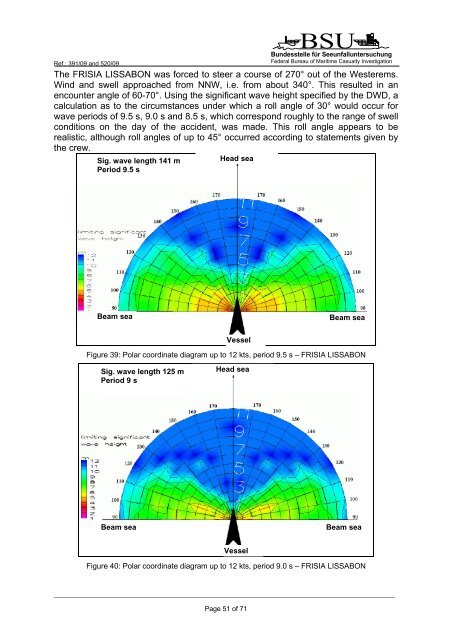SUB-COMMITTEE ON STABILITY AND LOAD LINES AND ON ...
SUB-COMMITTEE ON STABILITY AND LOAD LINES AND ON ...
SUB-COMMITTEE ON STABILITY AND LOAD LINES AND ON ...
You also want an ePaper? Increase the reach of your titles
YUMPU automatically turns print PDFs into web optimized ePapers that Google loves.
Ref.: 391/09 and 520/09<br />
BSU<br />
Bundesstelle für Seeunfalluntersuchung<br />
Federal Bureau of Maritime Casualty Investigation<br />
The FRISIA LISSAB<strong>ON</strong> was forced to steer a course of 270° out of the Westerems.<br />
Wind and swell approached from NNW, i.e. from about 340°. This resulted in an<br />
encounter angle of 60-70°. Using the significant wave height specified by the DWD, a<br />
calculation as to the circumstances under which a roll angle of 30° would occur for<br />
wave periods of 9.5 s, 9.0 s and 8.5 s, which correspond roughly to the range of swell<br />
conditions on the day of the accident, was made. This roll angle appears to be<br />
realistic, although roll angles of up to 45° occurred according to statements given by<br />
the crew.<br />
Sig. wave length 141 m<br />
Period 9.5 s<br />
Head sea<br />
Beam sea<br />
Beam sea<br />
Vessel<br />
Figure 39: Polar coordinate diagram up to 12 kts, period 9.5 s – FRISIA LISSAB<strong>ON</strong><br />
Sig. wave length 125 m<br />
Period 9 s<br />
Head sea<br />
Beam sea<br />
Beam sea<br />
Vessel<br />
Figure 40: Polar coordinate diagram up to 12 kts, period 9.0 s – FRISIA LISSAB<strong>ON</strong><br />
_____________________________________________________________________________________________________<br />
Page 51 of 71
















